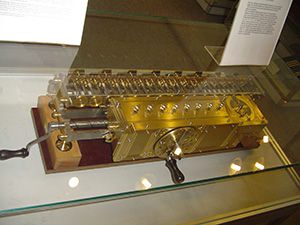Leibniz's Calculating Machine |
 |
In 1671 the German mathematician-philosopher Gottfried Wilhelm von Leibniz designed a calculating machine called the Step Reckoner. (It was first built in 1673.) The Step Reckoner expanded on Pascal's ideas and did multiplication by repeated addition and shifting.
Leibniz was a strong advocate of the binary system. Binary numbers are ideal for machines because they require only two digits, which can easily be represented by the on and off states of a switch. When computers became electronic, the binary system was particularly appropriate because an electrical circuit is either on or off. This meant that on could represent true, off could represent false, and the flow of current would directly represent the flow of logic.
Leibniz was prescient in seeing the appropriateness of the binary system in calculating machines, but his machine did not use it. Instead, the Step Reckoner represented numbers in decimal form, as positions on 10-position dials. Even decimal representation was not a given: in 1668 Samuel Morland invented an adding machine specialized for British money—a decidedly non-decimal system.
Copyright © 1994-2002 Encyclopædia Britannica, Inc.
![]()
Sources
- Encylopedia Britannica 2002, Expanded Edition DVD




